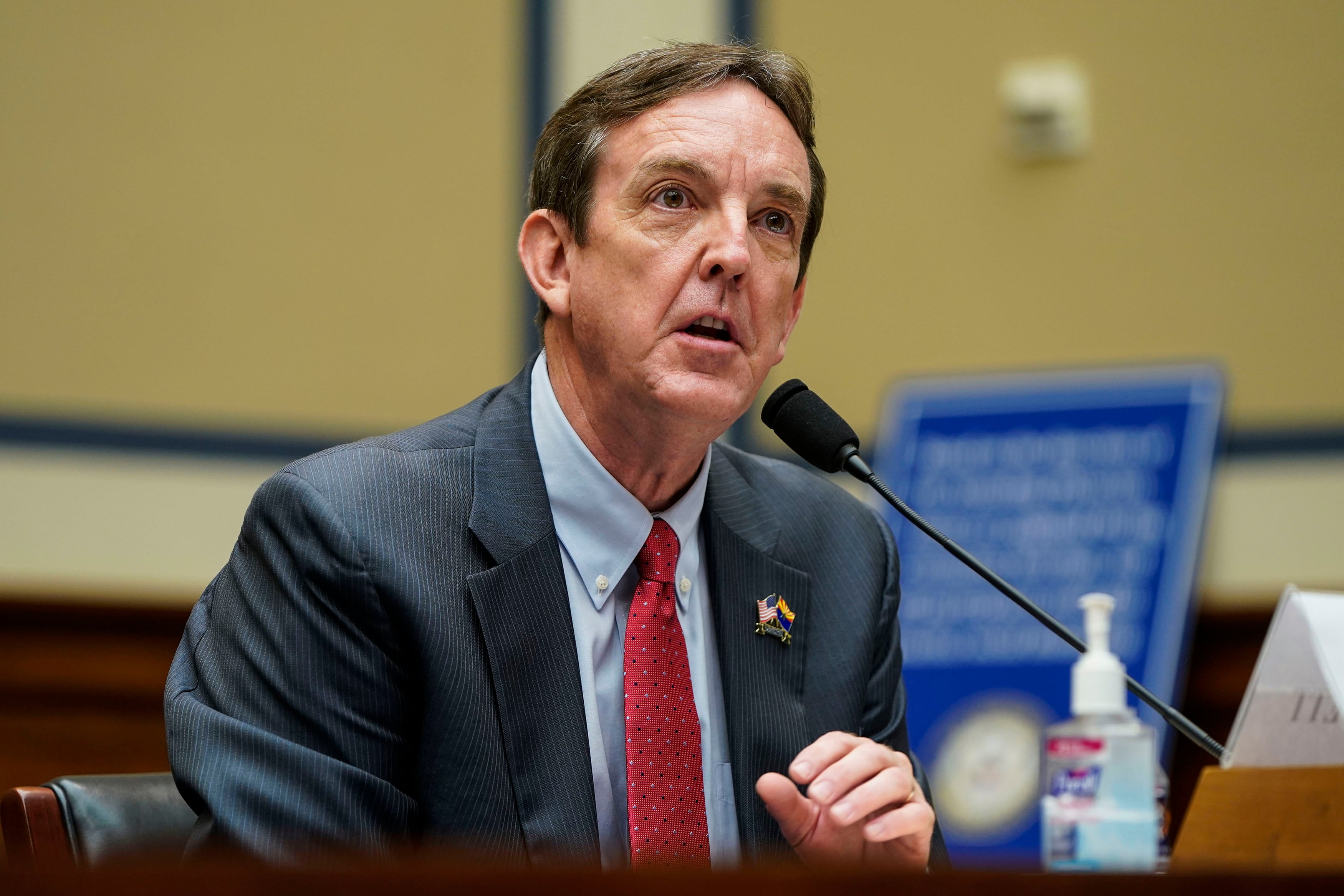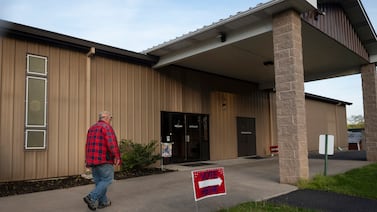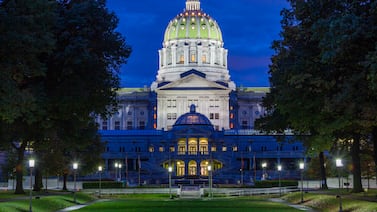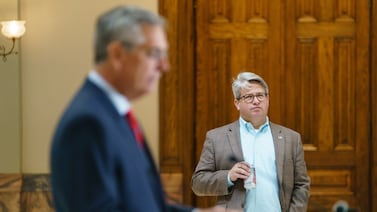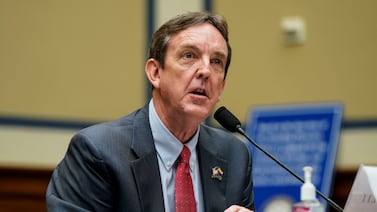Votebeat is a nonprofit news organization reporting on voting access and election administration across the U.S. Sign up for our free newsletters here.
Candidates for election in Arizona would potentially be able to verify the results in their race, ballot by ballot, under a proposal likely to end up in this year’s state budget.
State Sen. Ken Bennett, who is leading the effort, says his fellow Republican lawmakers endorse designating $2 million that’s already set aside in the budget for election integrity efforts to support the creation or adoption of a tool that would allow for this type of analysis.
Bennett’s budget proposal comes after he has tried for two years to pass related bills. By designating money in the budget instead of trying to get a bill passed, Bennett is circumventing the typical way new laws are publicly vetted.
The tool would provide a sortable database including voter registration records; a list of voters who voted in each election; the digital image of each ballot cast; and a record of how machines counted those votes, known as the “cast vote record.” Those with access — it’s still up in the air who would have it — could check for themselves that only eligible voters voted, see images of completed ballots, and examine how the machines counted the votes.
In a state that since 2020 has been riven by unproven claims of widespread election fraud, such a tool would be key to reducing frivolous court challenges to election results, and improving voter trust, said Bennett, a former secretary of state.
Secretary of State Adrian Fontes, a Democrat and longtime advocate of making ballot images public records, said in a phone interview Tuesday that he has been working with Bennett on the plan for the tool. Fontes believes the tool would “get rid of the election fraud nonsense.”
“Get rid of these lies and conspiracy theories once and for all,” Fontes said.
The main question is whether Gov. Katie Hobbs, also a Democrat, will let it stand in the budget. She, other Democratic lawmakers, and voting rights groups have previously said they’re concerned that the proposed tool could allow voters to be linked with their ballots, which under law must be kept private.
While ballots are anonymous by nature, Hobbs and others worry that some voters mistakenly write their names on the ballot, and releasing those images publicly could reveal how they voted. Also, in rare instances involving very small precincts, a close analysis of the cast vote record and voter registration records could allow someone to tie a ballot image to a particular voter.
But Bennett says he has thought of potential solutions. He met with Hobbs earlier this month and brought his plan up to her, according to her spokesperson, Christian Slater, but she “did not commit to the funding or endorse the idea.” Bennett said she told him she wants to see the details.
“The devil is always in the details,” Bennett said. “I think we can come up with something that election officials will embrace as a way to prove without a doubt that the election was done correctly.”
Budget proposal circumvents public comment
While Bennett has run his budget plan by Hobbs, he has not involved the voting rights groups that have led the opposition to his earlier bills. The group that represents election officials who would need to implement use of the new tool, the Arizona Association of Counties, also has not had an opportunity to review the plan, said Jen Marson, the association’s executive director.
Alex Gulotta, Arizona director of All Voting is Local, a group that advocates for voting rights, said that “cramming” this in the state budget is the worst way to conduct the public’s business.
“In an effort to provide transparency,” he said, “they are doing this in a non-transparent manner.”
Along with concerns about voter privacy, Gulotta and others worry that providing mass data about elections before results are certified will prompt activists to use it to inaccurately bolster false claims of widespread fraud.
For his part, Fontes said there has been too much “handwringing” about the idea.
Ballot images are already public records in some other states. At least some county election clerks, including from Democratic areas, have said it increased voter confidence.
In Dane County, Wisconsin, a heavily Democratic area that includes Madison, the state capital, elections clerk Scott McDonell said posting ballot images online, in some cases, has helped dissuade people who raise concerns about election fraud.
“In some ways it calls their bluff,” he said, “and typically they move on to somewhere that doesn’t do it.”
‘Come on in, we will show you’
The details of how it would work in Arizona are all still up in the air. That includes whether the state would use a tool already available from a company or organization or create a new one; how soon after an election it would be available; what data the tool would include; and who would have access to it. To all of this, Bennett said he is open to negotiations.
The state could get software from a company such as Clear Ballot, for example, which Maryland uses to do a digital audit of its election results and to make such records available to voters. Or it could call on Bennett’s friend John Brakey, co-founder of election integrity group Audit USA, which has been developing a tool that he says they would offer the state free.
As for access, Bennett wants the tool to be available publicly. But that would require a change to state law, because ballot images are not currently public records, and there’s debate over whether cast vote records are public records. Bennett said another option would be to make the tool available at state and county election offices, and to state lawmakers. Whoever uses it would sign some sort of agreement restricting their use of the tool.
“Just so we can verify to anyone who says, ‘Oh, I can’t have possibly lost Pinal County,’” Bennett said. “OK. Come on in. We will show you: Here are the people who are registered, here are the people who voted, here is a ballot image for everyone who voted — no more, no less.”
But he said the access can’t be restricted to just election officials. “It’s not just going to be the foxes guarding the henhouse,” Bennett said. “It’s not just another layer of government, of election officials telling you, ‘Oh yeah, it all works out. You don’t get to see it.’ No. We will show you everything you want to see.”
To protect voters who write their names on their ballots, he said, officials could use a mass redaction tool similar to one used in Colorado before they release the records. And if a voter in a small precinct could potentially be identified through analysis, their entire ballot could be redacted.
Bennett prefers that the tool be made available to candidates before the statewide election is certified, so they can analyze the data before results are final. But that raises questions about what happens if mistakes are caught during these reviews.
For example, the tool could allow candidates to scrutinize wondering why so many people didn’t vote in their race to look at these “undervotes” on each ballot, to ensure that voters truly didn’t mark a candidate in their race. This might reveal voter marks, such as circles around a bubble, that machines didn’t count as votes.
Bennett said that if that happens, election officials could simply update results based on what is found. Fontes also said he wasn’t worried about it.
Democrats in other states signal support
Fontes is familiar with how other Democratic-led states have championed the idea of putting ballot images online. He said part of the pushback here might have to do with the tense political climate, “and that’s silly.”
As Bennett and Fontes have pushed for the idea, Democrats from across the country have offered their support. Doug Kellner, at the time co-chair of New York State Board of Elections, wrote to Fontes in April 2023 thanking him for his “principled stand for election transparency.”
“I still strongly support the publication of ballot images and cast vote records as effective tools toward transparent and verifiable elections,” Kellner wrote. “It is disappointing that so many Arizona Democrats have reservations.”
The next month, Nikki Fried, chair of the Florida Democratic Party, wrote to Hobbs telling her to sign Bennett’s bill. “In my view, HB2560 is the type of election reform that should be embraced by everyone involved in the election process,” she wrote. “It should not be a partisan issue.”
In Dane County, McDonell said no one has ever used the data and images he posts publicly to spread misinformation. He likes the disclosure because then he knows that there is an official record out there, for people to refer to and analyze when misinformation does spread. He also hasn’t had any voter privacy concerns come up.
In Adams County, Colorado, elections clerk Stan Martin told a reporter in 2018 that he used Clear Ballot’s system to show candidates exactly how they won or lost.
“When the candidates left that room — these were races that were six votes apart — we had two candidates on the losing side say they felt 100% confident that the election [result] was 100% accurate,” Martin said at the time.
In Arizona, Bennett said he wants the tool in use for the upcoming primary election. Fontes said he has told Bennett that’s impossible, and that it would be “very, very, very difficult and very expensive, if at all possible, to do for the general in 2024.”
Jen Fifield is a reporter for Votebeat based in Arizona. Contact Jen at jfifield@votebeat.org.


